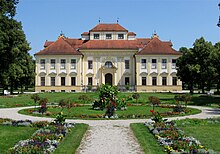Meissen porcelain collection Ernst Schneider Foundation
The Meissen Porcelain Collection Ernst Schneider Foundation is about the porcelain collection in Dresden world's largest collection of Meissen porcelain of the 18th century. Since 1968 the collection has been in the possession of the Bavarian National Museum, which set up a first branch museum in Lustheim Palace in the Schleissheim Palace complex for the valuable donation.
lock
Lustheim Palace was built between 1684 and 1688 according to designs by court architect Enrico Zuccalli . Elector Max Emanuel of Bavaria commissioned the building on the occasion of his engagement to the imperial daughter Maria Antonia. The pleasure palace , which forms the focal point and eastern end of the large park in Schleissheim , provided a festive setting for courtly hunting parties. The hunt is also a central theme of the ceiling paintings with scenes from the myth of Diana, the goddess of the hunt, in the tradition of the Italian high baroque.
collection
After extensive renovation, Lustheim Palace was established in 1971 as the first branch museum of the Bavarian National Museum . Since then, it has housed the world-famous collection of Meißen porcelain owned by the industrialist Ernst Schneider , the scope and importance of which is comparable to the porcelain collection in the Dresden Zwinger . The presentation of the more than 2000 exquisite porcelains offers an insight into the impressive diversity of the products of the Meissen manufactory and their almost inexhaustible inventiveness in the first decades from its foundation in the Meissen Albrechtsburg castle to the time of the Seven Years' War .
The tour begins with the earliest crockery and figures from Johann Friedrich Böttger's time as director , who, together with Ehrenfried Walther von Tschirnhaus, succeeded in re-inventing East Asian porcelain. No less famous are the porcelain painter Johann Gregorius Höroldt and the Höroldt chinoiseries named after him, of which the collection has outstanding examples. Schneider was particularly fond of the “Indian” decors based on the models of Chinese and Japanese porcelain, which August the Strong (1670–1733) particularly valued. The figurative vessels and lively animal figures by the Meißen modeller Johann Joachim Kändler are considered to be masterpieces of sculpture . A special highlight at the end of the tour are the numerous dishes from Count Sulkowski's dinner service and Count Brühl's legendary swan service , which give an idea of the glamor of baroque banquet tables.
Benefactor
Ernst Schneider (1900–1977), head of a group of companies under the umbrella company of Kohlensäure-Industrie AG based in Düsseldorf, to which chemical and cosmetic companies (including the Odol works) and steel processing belonged, was president of the Düsseldorf industrial and Chamber of Commerce (1948–1968) and President of the German Industry and Trade Congress (1963–1969).
In addition to his economic activity, Ernst Schneider promoted cultural institutions such as museums, art associations and theaters. In his private life, he collected paintings and graphics from the early 20th century as well as handicrafts from the 18th century, with Meißen porcelain particularly impressing him. After the fatal accident of his only son in 1968, he sold his group of companies and withdrew from all offices. From 1970 until his death he lived in Lustheim Palace.
literature
- Rainer Rückert : Lustheim Palace. Meissen porcelain collection, Ernst Schneider Foundation . Bavarian National Museum, Munich 1972 (further editions 1976, 1977, 1985).
- Rainer Rückert: Biographical data of the Meissen manufacturers of the 18th century (catalog of the Meissen porcelain collection, Ernst Schneider Foundation, Lustheim Palace, Oberschleißheim in front of Munich, branch museum of the Bavarian National Museum in Munich, supplement). Bavarian National Museum, Munich 1990, ISBN 3-925058-13-3 .
- Annette Schommers, Martina Grigat: Meissen porcelain of the 18th century. The Ernst Schneider Foundation in Lustheim Palace . CH Beck, Munich 2004, ISBN 3-406-51905-9 .




